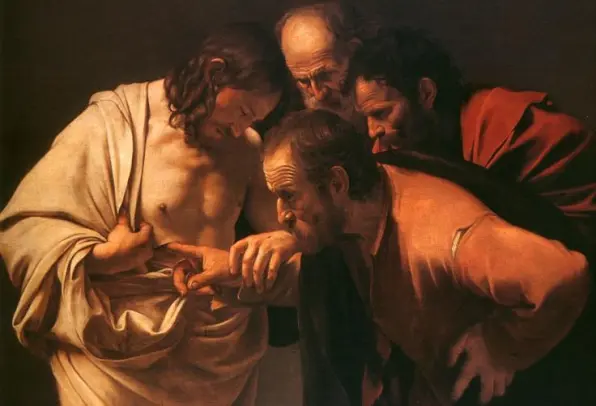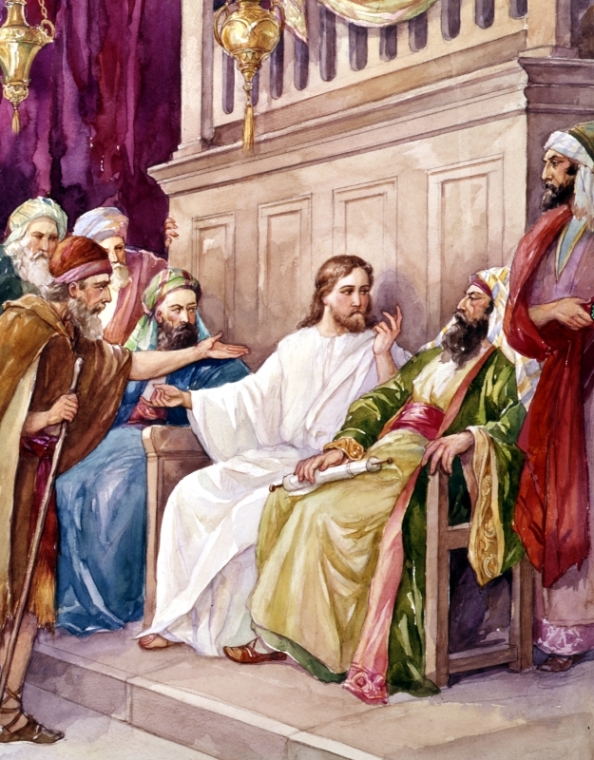Bloor Lansdowne Christian Fellowship – BLCF Church Message for Sunday:
‘Trust and Faith in the Lord: Our Keys to Hope, Joy and Peace’
© May 17, 2015, by Steve Mickelson
Announcements & Call to Worship: Responsive Reading #601(Faith and Confidence – Psalm 27); Prayer
Opening Hymn #235: “What Must I Do?” Choruses
Tithing and Prayer Requests: Hymn #572: Praise God; Prayers
Today’s Scriptures: Psalm 91:1-6, Matthew 13:53-58, John 20:19-29
Let us pray…
For our lesson today May 17, 2015, with Pentecost Sunday just one week away, I would like to discuss the disciple of Jesus who, thanks to a short passage of the Scriptures, has been tagged with the unfortunate moniker of a doubter or skeptic. As you have likely guessed, I am talking about Thomas or Didymus, which means “the twin”, who we more commonly refer to as: “Doubting Thomas.” Thomas comes from the Hebrew or Aramaic root which means “the twin.” Didymus is from the Greek and also means “the twin.” Thomas was likely born as a twin hence the unusual nickname.
But the skeptical response by Thomas to his fellow disciples, as described in the following Scripture in John 20, verses 19-29, helped to earn him the unfortunate title of doubter:
John 20:19-29 (ESV) Jesus Appears to the Disciples
19 On the evening of that day, the first day of the week, the doors being locked where the disciples were for fear of the Jews,[a] Jesus came and stood among them and said to them, “Peace be with you.” 20 When he had said this, he showed them his hands and his side. Then the disciples were glad when they saw the Lord. 21 Jesus said to them again, “Peace be with you. As the Father has sent me, even so I am sending you.” 22 And when he had said this, he breathed on them and said to them, “Receive the Holy Spirit. 23 If you forgive the sins of any, they are forgiven them; if you withhold forgiveness from any, it is withheld.”
Jesus and Thomas
24 Now Thomas, one of the Twelve, called the Twin,[b] was not with them when Jesus came. 25 So the other disciples told him, “We have seen the Lord.” But he said to them, “Unless I see in his hands the mark of the nails, and place my finger into the mark of the nails, and place my hand into his side, I will never believe.”
26 Eight days later, his disciples were inside again, and Thomas was with them. Although the doors were locked, Jesus came and stood among them and said, “Peace be with you.” 27 Then he said to Thomas, “Put your finger here, and see my hands; and put out your hand, and place it in my side. Do not disbelieve, but believe.” 28 Thomas answered him, “My Lord and my God!” 29 Jesus said to him, “Have you believed because you have seen me? Blessed are those who have not seen and yet have believed.”
Footnotes: a. John 20:19 Greek Ioudaioi probably refers here to Jewish religious leaders, and others under their influence, in that time b. John 20:24 Greek Didymus
To be clear in our terminology, I will refer to what I commonly “Wikibits.” So what is meant by the term “skeptic,” often applied to Thomas?
Dictionary.com: skeptic – noun
- A person who questions the validity or authenticity of something purporting to be factual.
- A person who maintains a doubting attitude, as toward values, plans, statements, or the character of others.
- A person who doubts the truth of a religion, especially Christianity, or of important elements of it.
Both the secular and Christian communities, make frequent use of the term “Doubting Thomas,” about Jesus’ disciples. Another idiom associated with Thomas is “Seeing is believing.”
Wikibits: Seeing is Believing
Seeing is believing is an idiom first recorded in this form in 1639 that means “only physical or concrete evidence is convincing”. It is the essence of St. Thomas‘s claim to Jesus Christ, to which the latter responded that there were those who had not seen but believed. It leads to a sophistry that “seen evidence” can be easily and correctly interpreted, when in fact, interpretation may be difficult.
http://en.wikipedia.org/wiki/Seeing_Is_Believing
The Scripture Verses, featured in today’s lesson and printed in this morning’s bulletin, talk about how important belief, trust, and faith are, in our faith walk, as believers in the Resurrected Christ.
In the first Scripture, taken from Psalm 91, verses 1-6, we see that trust and faithfulness are used interchangeably, describing a mutual regard between a believer and God. Just as we are faithful to God, He is faithful to us:
Psalm 91:1-6 (ESV) My Refuge and My Fortress
91 He who dwells in the shelter of the Most High
will abide in the shadow of the Almighty.
2 I will say[a] to the Lord, “My refuge and my fortress,
my God, in whom I trust.”
3 For he will deliver you from the snare of the fowler
and from the deadly pestilence.
4 He will cover you with his pinions,
and under his wings you will find refuge;
his faithfulness is a shield and buckler.
5 You will not fear the terror of the night,
nor the arrow that flies by day,
6 nor the pestilence that stalks in darkness,
nor the destruction that wastes at noonday.
Footnotes: a. Psalm 91:2 Septuagint He will say
The next Scripture passage in the bulletin is Matthew 13, verses 53-58, which describes how our Lord was rejected, despite his wisdom and miracles, because of the “unbelief” among many of the people in his hometown of Nazareth:
Matthew 13:53-58 (ESV) Jesus Rejected at Nazareth
53 And when Jesus had finished these parables, he went away from there, 54 and coming to his hometown he taught them in their synagogue, so that they were astonished, and said, “Where did this man get this wisdom and these mighty works? 55 Is not this the carpenter’s son? Is not his mother called Mary? And are not his brothers James and Joseph and Simon and Judas? 56 And are not all his sisters with us? Where then did this man get all these things?” 57 And they took offense at him. But Jesus said to them, “A prophet is not without honor except in his hometown and in his own household.” 58 And he did not do many mighty works there, because of their unbelief.
While John 20:19-29 does describe the doubts of Thomas, who was absent when Jesus first appeared to the other disciples in the Upper room on the day of his resurrection, the Lord did show the disciples the very same wounds that Thomas asked to see, as well as breathing the Spirit into the disciples, to help them understand the significance of what they were witnessing.
While Thomas was skeptical of the Lord, when he first encountered Jesus, he was by no means the only disciple to have doubts on that day. Let us look at a passage of Scripture, not found in some of the earlier manuscripts:
Mark 16:9-20 (ESV) Jesus Appears to Mary Magdalene
[Some of the earliest manuscripts do not include 16:9–20.][a]
9 [[Now when he rose early on the first day of the week, he appeared first to Mary Magdalene, from whom he had cast out seven demons. 10 She went and told those who had been with him, as they mourned and wept. 11 But when they heard that he was alive and had been seen by her, they would not believe it.
Jesus Appears to Two Disciples
12 After these things he appeared in another form to two of them, as they were walking into the country. 13 And they went back and told the rest, but they did not believe them.
The Great Commission
14 Afterward he appeared to the eleven themselves as they were reclining at table, and he rebuked them for their unbelief and hardness of heart, because they had not believed those who saw him after he had risen. 15 And he said to them, “Go into all the world and proclaim the gospel to the whole creation. 16 Whoever believes and is baptized will be saved, but whoever does not believe will be condemned. 17 And these signs will accompany those who believe: in my name they will cast out demons; they will speak in new tongues; 18 they will pick up serpents with their hands; and if they drink any deadly poison, it will not hurt them; they will lay their hands on the sick, and they will recover.”
19 So then the Lord Jesus, after he had spoken to them, was taken up into heaven and sat down at the right hand of God. 20 And they went out and preached everywhere, while the Lord worked with them and confirmed the message by accompanying signs.]]
Footnotes: a. Mark 16:9 Some manuscripts end the book with 16:8; others include verses 9–20 immediately after verse 8. At least one manuscript inserts additional material after verse 14; some manuscripts include after verse 8 the following: But they reported briefly to Peter and those with him all that they had been told. And after this, Jesus himself sent out using them, from east to west, the sacred and imperishable proclamation of eternal salvation. These manuscripts then continue with verses 9–20
In Mark 16, verses 9-20, the remaining eleven disciples demonstrated the same level of doubt and skepticism towards Mary and the two disciples on the Emmaus Road, when they had reported seeing Jesus on the day of his resurrection. And like, Thomas, the eleven were rebuked for their unbelief.
Our previous Upper Room account of the Resurrected Jesus appearing before the Eleven Disciples in John 20:19-29 does not give a reason why Thomas was absent. The disciples had cloistered themselves in the Upper Room because they feared that the angry mob would crucify them as they had the Lord. Whatever the reason for Thomas’ absence, whether it was to get food for the disciples or to attend to the needs of others, it was important enough for him to risk his own personal safety while the other disciples chose to stay behind a bolted door. We do know that the reason Thomas left the safety of the Upper Room, it was not for doing something nefarious, as was the case of Judas Iscariot, who betrayed Jesus for thirty pieces of silver. The Mark 16 account has the Lord returning specifically for the assurance of Thomas so that the disciple would believe. In the John 20 account, Jesus gave a mini-Pentecost, breathing upon the eleven the Holy Spirit which gave them the power of the Spirit and to understand the Lord’s purpose. Thomas being absent did not receive the Spirit at that time. The Lord’s prerequisite to receive the Holy Spirit is that a convert demonstrates faith in Jesus, which Christ ensured by his returning to the Upper Room to reveal himself to Thomas. This was an act of both compassion and faith by the Lord and shows us that he would not leave any of his sheep behind.
Unfortunately, Thomas bears the brunt of the blame for his skepticism towards the others’ news of the Lord’s resurrection, which overshadows the ministry that Thomas performed in spreading the Gospel of Christ, which is the “Great Commission” given by Jesus to all the disciples. In the sharing of the Gospel, the disciples became apostles or messengers of Christ. Here is a brief summary of the work of the Apostle Thomas, which is really germane to his work:
Thomas the Apostle (called Didymus which means “the twin”) was one of the Twelve Apostles of Jesus Christ, according to the New Testament. He is informally called doubting Thomas because he doubted Jesus’ resurrection when first told, (in the Gospel of John), followed later by his confession of faith, “My Lord and my God”, on seeing Jesus’ wounded body.
Traditionally, he is said to have traveled outside the Roman Empire to preach the Gospel, traveling as far as India.[2][5][6][7] According to tradition, the Apostle reached Muziris, India in AD 52 and baptized several people, founding what today are known as Saint Thomas Christians or Nasranis. After his death, the reputed relics of Saint Thomas the Apostle were enshrined as far as Mesopotamia in the 3rd century, and later moved to various places.[citation needed] In 1258, some of the relics were brought to Abruzzo in Ortona, Italy, where they have been held in the Church of Saint Thomas the Apostle.[8] He is often regarded as the Patron Saint of India,[9][10] and the name Thoma remains quite popular among Saint Thomas Christians of India.
http://en.wikipedia.org/wiki/Thomas_the_Apostle
I feel that by focusing on an account that describes Thomas as having some doubts, which were no more severe than those exhibited by the other disciples, instead of his service in spreading the Gospel as far east as India, we do the apostle a disservice.
The New Testament is full of accounts describing the disciples as having doubts or lapses of faith, particularly before receiving the Holy Spirit. But the work that the disciples, now as apostles or messengers of the Gospel, accomplished by them, even to the point of their own deaths, is far more significant to the Christian Church of believers, The Apostle Thomas is included as an important contributor to the Great Commission given to all believers in Jesus, as Lord and Savior.
Let us pray…
Closing Hymn #317: Blessed Assurance, Jesus Is Mine
Benediction – (Romans 15:13): May the God of hope fill you with all joy and peace in believing, so that by the power of the Holy Spirit you may abound in hope.













[…] View 42 Trust and Faith in the Lord: Our Keys to Hope, Joy and Peace […]
LikeLike